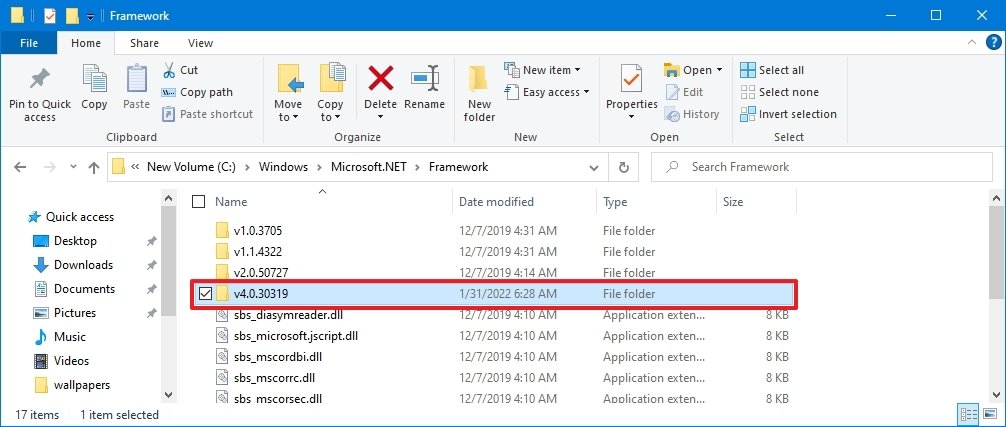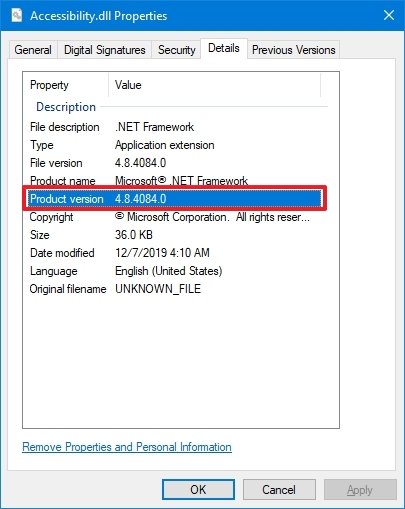On Windows 10. the “.NET Framework” (“dot net”) is a development platform made up of programming languages, libraries, and tools for programmers to build different types of applications for desktops, laptops, tablets, web apps, games, and more.
The .NET platform is not limited to Windows since it is open-source and cross-platform, which means it’s also supported on macOS and Linux.
Although regular users rarely need to worry about the version of .NET installed on Windows 10, some apps require specific releases to install and run as intended. In addition, developers typically have to use multiple versions of the development platform to build their applications. This means that knowing the version of .NET installed on the computer can come in handy depending on the situation.
Whether you are a developer or an everyday user, Windows 10 provides at least four ways to check the .NET Framework version using File Explorer, Registry, Command Prompt, and PowerShell.
In this Windows 10 guide, we will walk you through the steps to determine the .NET Framework version installed on your computer.
How to check .NET version using File Explorer
To use File Explorer to check the .NET Framework version on Windows 10, use these steps:
- Open File Explorer.
-
Browse the following path:
C:WindowsMicrosoft.NETFramework -
Enter the folder with the latest version — for example, v4.0.30319.
Source: Windows Central
-
Right-click any of the “.dll” files and select the Properties option.
Source: Windows Central
- Click the Details tab.
-
In the “Product version” section, confirm the version of .NET — for example, 4.8.4084.0.
Source: Windows Central
Once you complete the steps, the file details will reveal the framework platform’s version installed on the device.
How to check .NET version using Registry
To determine the .NET Framework version through the Registry, use these steps:
- Open Start.
- Search for regedit and click the top result to open the Registry.
-
Browse the following path:
HKEY_LOCAL_MACHINESOFTWAREMicrosoftNET Framework SetupNDP -
Expand the main version key – for example, v4 or v4.0.
-
Select the Client key.
Source: Windows Central
Quick tip: In releases older than version 4, the key will be a number or “Setup.” For example, .NET version 3.5 includes the version number under the 1033 key.
- On the right, check the “Version” string to determine the release of the .NET Framework.
After you complete the steps, you will know the releases of the Microsoft framework available on Windows 10.
How to check .NET version with Command Prompt
To check the version of the .NET Framework with Command Prompt, use these steps:
- Open Start.
- Search for Command Prompt, right-click the top result, and select the Run as administrator option.
-
Type the following command to determine the version of .NET installed and press Enter:
reg query "HKLMSOFTWAREMicrosoftNet Framework SetupNDP" /sSource: Windows Central
To make sure that version 4.x is installed, use this variant of the command:
reg query "HKLMSOFTWAREMicrosoftNet Framework SetupNDPv4" /sSource: Windows Central
- Check the “Version” field to confirm the releases of the .NET Framework installed on Windows 10.
Once you complete the steps, the versions of .NET running on the computer will be revealed.
How to check .NET version with PowerShell
To check the .NET version with PowerShell, use these steps:
- Open Start.
- Search for PowerShell, right-click the top result, and select the Run as administrator option.
-
Type the following command to check the version of .NET installed and press Enter:
Get-ChildItem 'HKLM:SOFTWAREMicrosoftNET Framework SetupNDP' -Recurse | Get-ItemProperty -Name version -EA 0 | Where { $_.PSChildName -Match '^(?!S)p{L}'} | Select PSChildName, versionSource: Windows Central
- Confirm the version of the .NET Framework installed on Windows 10.
After you complete the steps, PowerShell will return the information for both the client and the full version of .NET installed on Windows 10 (if applicable).
More Windows resources
For more helpful articles, coverage, and answers to common questions about Windows 10 and Windows 11, visit the following resources:











